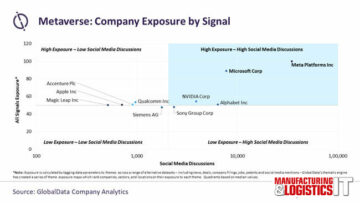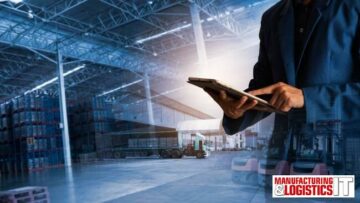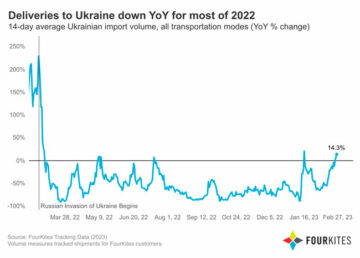By Stephan Sieber, CEO, Transporeon.
The ability to tap into data is critical to business success – from predicting sales trends to improving operations and customer service. This gives companies the insights they need to outperform the competition, and today’s business leaders clearly recognise the value of data.
However, these game-changing insights are elusive for many companies, with 58% of organisations basing at least half of their regular business decisions on gut feel rather than on data and information. ‘Laggard’ companies base 70% of their decisions on gut feel, while ‘best-in-class’ companies base 60% of their decisions on relevant information.

In the logistics industry specifically, the ripple effects of the last few years – and the ongoing recovery – across supply chain processes have clearly revealed the urgent need for organisations to embrace a data-driven culture. It’s not enough to just have access to data. Data must become a central component of logistics operations, built into the fabric of the business. Stephan Sieber, CEO at Transporeon explores this further…
The journey to being data driven
Aside from the cultural shift required, one of the biggest industry challenges associated with data-based decision making has been aggregating data from many disparate systems. Logistics practitioners highlight this as the biggest factor inhibiting their ability to convert data into actionable insights, followed by a lack of trained analysts and poor data quality .
The good news is that supply chain businesses recognise the need to leverage real-time data across their operations. And as a result, having accurate ETAs on transports is essential to managing supply chains and operations more efficiently. However, there’s a significant difference between just seeing what’s happening and being able to instantaneously use that information in an impactful way.
This is where a modern transportation management platform comes into play. Integrating different elements of the supply chain into an intelligent platform will serve as the backbone for data-driven decision making in large transportation networks. This approach can also connect shippers, carriers, logistics service providers and other stakeholders, enabling them to communicate, share data, and make smarter decisions based on a larger pool of data.
The more stakeholders that participate in the network, the more data that can be generated and analysed to deliver business value – from optimising loading and unloading through smart slot management, to scaling operations and cutting emissions. So, in 2023 and beyond, how do businesses get the most out of their transportation management data and transform their operations like never before?
Unlocking data value
The power of bringing key services and tools together in one comprehensive platform is that it delivers insights along the 360-degree lifecycle of a freight transaction. Having access to this data can provide several benefits, such as the ability to analyse market performance. With multiple stakeholders connected to a single platform, processing millions of real-time transactions annually, a network-based transportation management platform can help businesses benchmark their performance against the market.
Businesses must contextualise the data being collected by aligning it with clearly defined Key Performance Indicators (KPIs) linked to desired outcomes and business objectives. In the transportation realm, common KPIs include on-time delivery, on-time arrival, transportation spend by mode, lead times, and tender acceptance rate. These KPIs can then be compared to external network-wide benchmarks to help organisations see how they are performing relative to the market.
But the true value of being data-driven comes when businesses layer artificial intelligence, machine learning and visualisation tools on top of the data. This unlocks new insights about the businesses’ operations and generates recommendations on how to strive forward smarter. This could include: monitoring industry-wide freight spend and tender rates to optimise their freight procurement process; using AI-powered smart tendering to enable autonomous tendering; or analysing network-wide capacity information to reduce empty miles.
By choosing a modern, intelligent transportation management platform as the foundation of a connected network that prioritises real-time data, companies can unlock the insights that help them reduce costs and carbon emissions while improving service, mitigating risks, and much more. They can finally make smarter decisions based on actual data, not gut feeling.
- SEO Powered Content & PR Distribution. Get Amplified Today.
- PlatoData.Network Vertical Generative Ai. Empower Yourself. Access Here.
- PlatoAiStream. Web3 Intelligence. Knowledge Amplified. Access Here.
- PlatoESG. Automotive / EVs, Carbon, CleanTech, Energy, Environment, Solar, Waste Management. Access Here.
- PlatoHealth. Biotech and Clinical Trials Intelligence. Access Here.
- ChartPrime. Elevate your Trading Game with ChartPrime. Access Here.
- BlockOffsets. Modernizing Environmental Offset Ownership. Access Here.
- Source: https://www.logisticsit.com/articles/2023/08/16/how-to-unlock-the-value-of-data-driven-logistics
- :has
- :is
- :not
- :where
- 2023
- 360-degree
- a
- ability
- Able
- About
- acceptance
- access
- Access to data
- accurate
- across
- actual
- against
- AI-powered
- aligning
- along
- also
- an
- analyse
- Analysts
- and
- Annually
- approach
- ARE
- arrival
- artificial
- artificial intelligence
- AS
- associated
- At
- autonomous
- Backbone
- base
- based
- BE
- become
- been
- before
- being
- Benchmark
- benchmarks
- benefits
- between
- Beyond
- Biggest
- Bringing
- built
- business
- Business Leaders
- businesses
- by
- CAN
- Capacity
- carbon
- carbon emissions
- carriers
- central
- ceo
- chain
- chains
- challenges
- choosing
- clearly
- comes
- Common
- communicate
- Companies
- compared
- competition
- component
- comprehensive
- Connect
- connected
- convert
- Costs
- could
- critical
- cultural
- Culture
- customer
- Customer Service
- cutting
- data
- data quality
- data-driven
- decision
- Decision Making
- decisions
- defined
- deliver
- delivers
- delivery
- desired
- difference
- different
- disparate
- do
- effects
- efficiently
- elements
- embrace
- Emissions
- enable
- enabling
- enough
- essential
- explores
- external
- fabric
- factor
- feel
- few
- Finally
- followed
- For
- Forward
- Foundation
- freight
- from
- further
- generated
- generates
- get
- gives
- good
- Half
- Happening
- Have
- having
- help
- Highlight
- How
- How To
- However
- HTTPS
- impactful
- improving
- in
- include
- Indicators
- industry
- information
- insights
- instantaneously
- Integrating
- Intelligence
- Intelligent
- into
- IT
- journey
- jpg
- just
- Key
- Lack
- large
- larger
- Last
- layer
- lead
- leaders
- learning
- least
- Leverage
- lifecycle
- like
- linked
- loading
- logistics
- Logistics Service Providers
- machine
- machine learning
- make
- Making
- management
- managing
- many
- Market
- market performance
- millions
- mitigating
- mitigating risks
- Mode
- Modern
- monitoring
- more
- most
- much
- multiple
- must
- Need
- network
- network-based
- networks
- never
- New
- news
- objectives
- of
- on
- ONE
- ongoing
- Operations
- optimise
- or
- Organisations
- Other
- out
- outcomes
- Outperform
- participate
- performance
- performing
- platform
- plato
- Plato Data Intelligence
- PlatoData
- Play
- pool
- poor
- power
- predicting
- process
- processes
- processing
- procurement
- provide
- providers
- quality
- Rate
- Rates
- rather
- real-time
- real-time data
- realm
- recognise
- recommendations
- recovery
- reduce
- regular
- relative
- relevant
- required
- result
- Revealed
- Ripple
- risks
- sales
- scaling
- see
- seeing
- serve
- service
- service providers
- Services
- several
- Share
- shift
- significant
- single
- slot
- smart
- smarter
- So
- specifically
- spend
- stakeholders
- strive
- success
- such
- supply
- supply chain
- Supply chains
- Systems
- Tap
- Tender
- than
- that
- The
- their
- Them
- then
- These
- they
- this
- Through
- times
- to
- today’s
- together
- tools
- top
- trained
- transaction
- Transactions
- Transform
- transportation
- Trends
- true
- true value
- unlock
- unlocks
- urgent
- use
- using
- value
- Way..
- when
- while
- will
- with
- years
- zephyrnet












